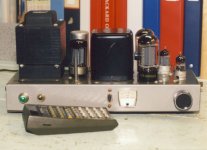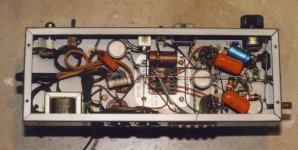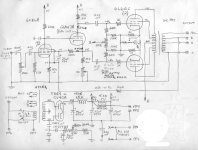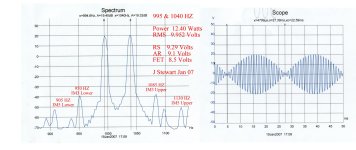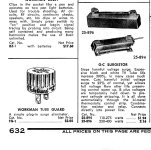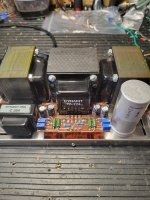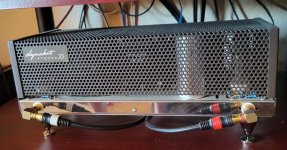You may ask, has jhstewart9 ever built an amplifier such as this. The answer is 'of course, here are a pair of monoblocks'.
I built these around 1960, I was interning & didn't have a lot of money. They have a DF of better than 10. And 3rd order intermods down 60 db.
These were my daily drivers at home for 17 yrs. Ohmite pots are use to set Bias, AC balance & DC balance. They are still here on the shelf.
The workbench here 18 feet long, built of 2x12 construction grade spruce. And plenty of shelf space on both sides. I retired the bike a while after 85.
During that period we had a lot of parties, no one ever came & asked what Rs or Cs I used. And after a couple of beers no one cared.
After I graduated to HP I treated myself to a matching Sansui setup, AU717 & TU717. My music collection includes a broad variety,
on Vinyl, CDs & Tape.
I built these around 1960, I was interning & didn't have a lot of money. They have a DF of better than 10. And 3rd order intermods down 60 db.
These were my daily drivers at home for 17 yrs. Ohmite pots are use to set Bias, AC balance & DC balance. They are still here on the shelf.
The workbench here 18 feet long, built of 2x12 construction grade spruce. And plenty of shelf space on both sides. I retired the bike a while after 85.
During that period we had a lot of parties, no one ever came & asked what Rs or Cs I used. And after a couple of beers no one cared.
After I graduated to HP I treated myself to a matching Sansui setup, AU717 & TU717. My music collection includes a broad variety,
on Vinyl, CDs & Tape.
Attachments
The answer is 'of course, here are a pair of monoblocks'.
Very nice. I love the vintage calculator in the first picture.
When will the soldering iron be plugged in? 😀
Not for a long time, so if you are in a hurry, come back in 6-8 weeks. At this point I am still reading the directions. I don't even have driver tubes yet, although I did order a quad of 6P14P-ER new old stock for $85 delivered.
The DC blocking capacitors on the input grids? Depends on the preamp upstream.
A cheap Chinese DAC. I wasn't expecting much from it, but the little DAC sounds great to me, so I ordered another one to tinker with. My current EL84 tube amp, built a few months ago from a Chinese kit, doesn't have an input cap there, and everything seems fine running from the cheap Chinese DAC, so I think I'll skip the cap like most people do these days.
Last edited:
Here is a very interesting find:
I have a Dynaco SCA-35 integrated amp that I heavily restored, and it sounds amazing. I've been using the EL84H tubes from Jim McShane, and they sound fine. I put either the CL-80 or CL-90 (can't remember which) on the hot leg of the line cord input, I think it was right after the fuse. These devices work by heating up (resistance decreases to almost zero as it gets hot), so putting it on the hot leg makes sense. If you have it on the neutral leg, I'm not sure it would ever really work. After I installed mine, the B+ was delayed getting to normal by about 10-20 seconds, which is a nice ramp up, instead of jumping to >400V then dropping.
Source
I expected more like 3-5 seconds, not 10-20.
I have a Dynaco SCA-35 integrated amp that I heavily restored, and it sounds amazing. I've been using the EL84H tubes from Jim McShane, and they sound fine. I put either the CL-80 or CL-90 (can't remember which) on the hot leg of the line cord input, I think it was right after the fuse. These devices work by heating up (resistance decreases to almost zero as it gets hot), so putting it on the hot leg makes sense. If you have it on the neutral leg, I'm not sure it would ever really work. After I installed mine, the B+ was delayed getting to normal by about 10-20 seconds, which is a nice ramp up, instead of jumping to >400V then dropping.
Source
I expected more like 3-5 seconds, not 10-20.
Yes, I take that 10-20 seconds with a large pinch of salt. I think that SCA35 is just working the way God intended, and the 10-20 seconds s attributed to the wonders of the thermistor.
I am always fitting a CL90 on the primary side, and a CL140 on the B+, as per George Tubelab's advice for the SPP. It is more to reduce the surge on the transformer, and make the heaters come up a tad slower, so there is no flash on turn on. Plus it shaves a couple of volts of B+ which can be handy.
I am always fitting a CL90 on the primary side, and a CL140 on the B+, as per George Tubelab's advice for the SPP. It is more to reduce the surge on the transformer, and make the heaters come up a tad slower, so there is no flash on turn on. Plus it shaves a couple of volts of B+ which can be handy.
Before current limiting resisters were common many people used one of these simple devices.
I got a Workman Tube Guard for my daily use amps & later kept it here on the workbench.
It finally failed about a year ago.
I got a Workman Tube Guard for my daily use amps & later kept it here on the workbench.
It finally failed about a year ago.
Attachments
I built my ST-35 adding the choke, CL-90 thermistor and better RCA jacks.
I also added taller feet for better air circulation. Later I added a bias board kit someone sold me at a discounted price. I also used Sovtek EL84M's and JJ driver tubes. I have a lot of other amplifiers, but this one is one of my favorites.
I've been playing with the 6P14P-P's in a single ended amp I built and a modified Magnavox 9303 console amp. I like the 6P14P's, so I'm ordering a quad of
6P14P-EV's to try in the ST-35.
I also added taller feet for better air circulation. Later I added a bias board kit someone sold me at a discounted price. I also used Sovtek EL84M's and JJ driver tubes. I have a lot of other amplifiers, but this one is one of my favorites.
I've been playing with the 6P14P-P's in a single ended amp I built and a modified Magnavox 9303 console amp. I like the 6P14P's, so I'm ordering a quad of
6P14P-EV's to try in the ST-35.
Attachments
Anybody have experience with something other than the JJ brand 12DW7 driver tube, preferably something affordable?
My next step is the chassis work for three properly spaced binding posts and a rocker switch that I think will just fit on the front panel. Still waiting on parts.
Looks like my empty cap can will be stuffed with 3 x 120uF 450V as that's the max that will fit.
My next step is the chassis work for three properly spaced binding posts and a rocker switch that I think will just fit on the front panel. Still waiting on parts.
Looks like my empty cap can will be stuffed with 3 x 120uF 450V as that's the max that will fit.
Last edited:
No, but my last listening experience with JJ tubes wasn't positive. I ended up giving away a quad of JJ EL34's after a few hundred hours of listening.
I've never had an issue with the JJ signal tubes. I did have a KT-77 fail with low hours. Not a big fan of there power tubes. I've used various JJ signal tubes and never got a microphonic or noisy one.
My 7247's were noisy-Anybody have experience with something other than the JJ brand 12DW7 driver tube, preferably something affordable?
Schem'd voltages were right on ST-35 chart... lots of hum.
Changed to JJ ECC832, problem solved... is that the JJ tube you're using?
Jim
I haven't bought driver tubes for the kit yet. I just want a really good pair of driver tubes for a fair price. My tests over the past few days with 6N1, 6N1P, and 6N1P-EV in my other amp reminded me just how important driver tubes are to the sound. I don't want drivers that have muddy bass or weak sub-bass, which is what I found in the other amp with the 6N1P tubes. 6N1 and 6N1P-EV in that amp had well-defined bass and strong sub-bass. I was surprised at the difference. Glad I tried all three.
Well,
I've got strong bass/ sub bass cuz of how I wire my OT's-
Using Hammond 1620's- the 8 ohm taps running thru first order passive cross to mid's and tweets-
The 4 ohm taps go direct to pair of 12" Dayton DVC 8 ohms wired in parallel w/ shunt caps in separate 3" vented enclosures.
It works... ask the neighbors- lol
Jim
I've got strong bass/ sub bass cuz of how I wire my OT's-
Using Hammond 1620's- the 8 ohm taps running thru first order passive cross to mid's and tweets-
The 4 ohm taps go direct to pair of 12" Dayton DVC 8 ohms wired in parallel w/ shunt caps in separate 3" vented enclosures.
It works... ask the neighbors- lol
Jim
I have no idea where I found this, and thank Heaven I saved a copy. It discusses and calculates the correct values for the NFB C7 and R10 when moving from the 16 ohm tap as in the original to the 8 ohm tap as in this kit. Reposting here for reference:
1. The original NFB loop as connected to the 16 Ohm winding is basically made up of a 27K resistor in series with a 1.3K resistor (the input stage cathode resistor), for a total of 28.3K. The connection of the 150K positive feedback resistor to this cathode is electrically irrelevant for this exercise.
2. Since the voltage appearing at the 8 Ohm tap represents 70.7% of the voltage appearing at the 16 Ohm tap, then the total loop resistance also needs to be reduced to 70.7% of its original value.
3. 70.7% of 28.3K is 20.008K.
4. From 20.008K you subtract the 1.3K cathode resistance, which remains a fixed value. That leaves the NFB resistor as being 18.708K, or 18.7K as I indicated.
5. Since the feedback network represents a time constant, the effort then is to keep the same time constant with the new 8 Ohm feedback resistor value, as was achieve with the old 16 Ohm resistor value.
6. This can be determined by keeping the product of the feedback resistor and capacitor combination the same between the two networks. This can be kept simple by retaining the units that the existing components were originally specified in.
7. Therefore: 27(K) X 27(pF) = 729. 729 / 18.7(K) = 38.98 or 39 pF as indicated.
However, the discussion and calculations above do not address the value of C6. Some online have suggested that it be changed from 18pF to 15pF. Thoughts anyone?
1. The original NFB loop as connected to the 16 Ohm winding is basically made up of a 27K resistor in series with a 1.3K resistor (the input stage cathode resistor), for a total of 28.3K. The connection of the 150K positive feedback resistor to this cathode is electrically irrelevant for this exercise.
2. Since the voltage appearing at the 8 Ohm tap represents 70.7% of the voltage appearing at the 16 Ohm tap, then the total loop resistance also needs to be reduced to 70.7% of its original value.
3. 70.7% of 28.3K is 20.008K.
4. From 20.008K you subtract the 1.3K cathode resistance, which remains a fixed value. That leaves the NFB resistor as being 18.708K, or 18.7K as I indicated.
5. Since the feedback network represents a time constant, the effort then is to keep the same time constant with the new 8 Ohm feedback resistor value, as was achieve with the old 16 Ohm resistor value.
6. This can be determined by keeping the product of the feedback resistor and capacitor combination the same between the two networks. This can be kept simple by retaining the units that the existing components were originally specified in.
7. Therefore: 27(K) X 27(pF) = 729. 729 / 18.7(K) = 38.98 or 39 pF as indicated.
However, the discussion and calculations above do not address the value of C6. Some online have suggested that it be changed from 18pF to 15pF. Thoughts anyone?
OEM are around 30 bucks. GE/RCA/Sylvania likely GE restampsAnybody have experience with something other than the JJ brand 12DW7 driver tube, preferably something affordable?
My next step is the chassis work for three properly spaced binding posts and a rocker switch that I think will just fit on the front panel. Still waiting on parts.
Looks like my empty cap can will be stuffed with 3 x 120uF 450V as that's the max that will fit.
C6 should keep the same value. It's for open loop rolloff and is independent of secondary taps.
All good fortune,
Chris
All good fortune,
Chris
Thread readers,
1. How long ago did you purchase your JJ tubes?
How old was the stock?
2. Did you purchase them from Eurotubes.com?
I know the people there, I know their extensive re-testing for all kinds of tube specs and noise, etc.
I know one of the designers of a few of their highly specialized test equipments (I used to work with him at a major test and measurement company); and I know one of Eurotubes test equipment designers too.
I need some more JJ tubes, so this week or next week, I am planning to drive over and pick up some excellent JJ tubes. Lucky me.
P.S. I am a firm believer of not using tubes Either at, Or above their maximum ratings.
Need more power, use a more powerful tube.
We are talking Hi Fi / Stereo on this thread.
We are not talking about a Gig in a Rock Concert that will blow out three things (your ears, your PA speakers, and the guitar amplifier).
1. How long ago did you purchase your JJ tubes?
How old was the stock?
2. Did you purchase them from Eurotubes.com?
I know the people there, I know their extensive re-testing for all kinds of tube specs and noise, etc.
I know one of the designers of a few of their highly specialized test equipments (I used to work with him at a major test and measurement company); and I know one of Eurotubes test equipment designers too.
I need some more JJ tubes, so this week or next week, I am planning to drive over and pick up some excellent JJ tubes. Lucky me.
P.S. I am a firm believer of not using tubes Either at, Or above their maximum ratings.
Need more power, use a more powerful tube.
We are talking Hi Fi / Stereo on this thread.
We are not talking about a Gig in a Rock Concert that will blow out three things (your ears, your PA speakers, and the guitar amplifier).
Last edited:
The JJ driver tubes have been in my ST-35 for a couple years now. This amp get a lot of use too. I have read in various post on several sites that the JJ EL-84's are one of the better power tubes to use in these amplifiers, but I've haven't tried them yet.
The Sovtek.EL-84M's I'm using are holding up just fine though. They hold bias and recently when I installed the Dynakit bias board, I tested them and they still test new.
The Sovtek.EL-84M's I'm using are holding up just fine though. They hold bias and recently when I installed the Dynakit bias board, I tested them and they still test new.
I’m confused. Given the title of this thread what are you talking about? Earlier you said this.I haven't bought driver tubes for the kit yet. I just want a really good pair of driver tubes for a fair price. My tests over the past few days with 6N1, 6N1P, and 6N1P-EV in my other amp reminded me just how important driver tubes are to the sound. I don't want drivers that have muddy bass or weak sub-bass, which is what I found in the other amp with the 6N1P tubes. 6N1 and 6N1P-EV in that amp had well-defined bass and strong sub-bass. I was surprised at the difference. Glad I tried all three.
Anybody have experience with something other than the JJ brand 12DW7 driver tube, preferably something affordable?
Last edited:
- Home
- Amplifiers
- Tubes / Valves
- New DynaKitParts ST-35 Build
